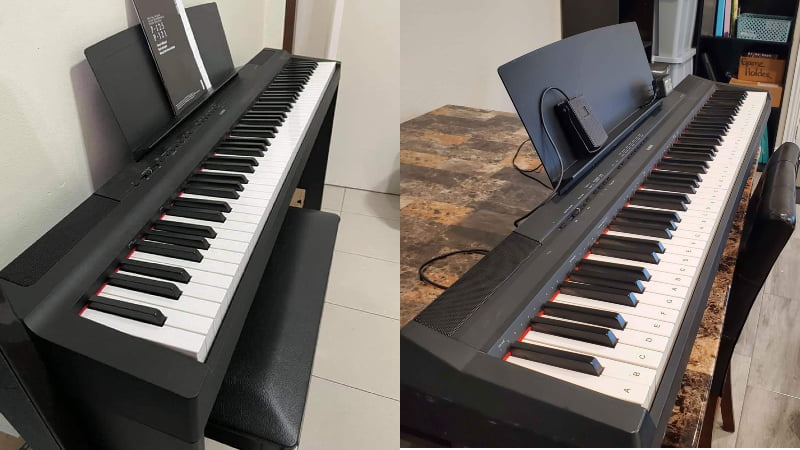The Yamaha P115 used to be the gold standard for entry-level digital pianos for beginners and novices. However, in 2018, that changed when Yamaha discontinued the P115 and replaced it with the upgraded Yamaha P125. And after comparing both machines, I found that the Yamaha P125 is a true upgrade over the P115.
When comparing the Yamaha P115 vs P125, I found that the P125 is the more versatile option. It comes with more voices, effects, better app integration, more preset songs, and most importantly, it’s still available on most Yamaha stores. In comparison, the P115 is mostly discontinued and can be very hard to find.
The P115 still has its set of advantages, however, which made writing this comparison a whole lot of fun. With great piano tones, decent feel, and a low price, the Yamaha P115 is still a very attractive digital piano for beginners.
Yamaha P115 vs P125: Comparison Chart


Last update on 2025-07-14 / Affiliate links / Images from Amazon Product Advertising API
Yamaha P115 vs P125: Differences
When comparing these two pianos, I found that the P125 beat out the P115 by 3-1, which is predictable, considering that it’s the upgraded model. The main reason the P125 has better features is because of its wider sound library and extra features that make it a great piano for beginners and novices alike.
Feel & Playability
The winner: Tie
One of the things that Yamaha kept the same when they introduced the P125 is the key texture and hammer action. Both of these features are exactly the same on both pianos. They provide a semi-realistic feel akin to an acoustic piano, and is one of the top features of both the Yamaha P115 and the P125.
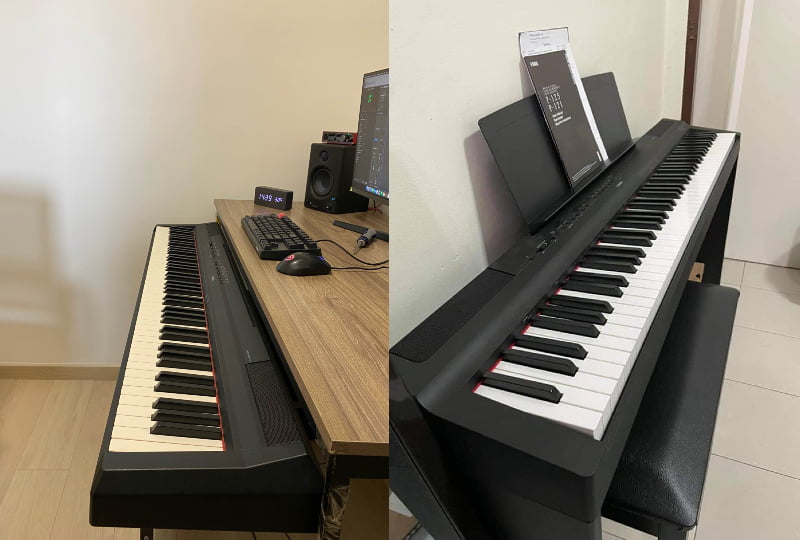
Key Texture
When I heard that Yamaha was replacing the P115 with the P125, I was really hoping that they improved the key texture. Sadly, both the P115 and P125 have plastic keys that don’t have any coating to make it feel like an acoustic instrument. So, when you play either of these pianos, you can expect the keys to feel like plastic. This is kind of a let down, as the key texture was a common complaint users had with the P115 and it’s sad that the P125 didn’t improve on that.
Hammer Action
While the key texture of both models was a slight let down, the hammer action of both instruments is great. They both feature the Graded Hammer System (GHS) for which Yamaha digital pianos are known. The Graded Hammer System features heavier keys on the left side and lighter keys on the right side. This mimics the hammer action of an acoustic piano and is very realistic. So, if you need a digital piano that feels like an acoustic piano when it comes to hammer action, either of these pianos is a great choice.
Tone
The winner: Yamaha P125
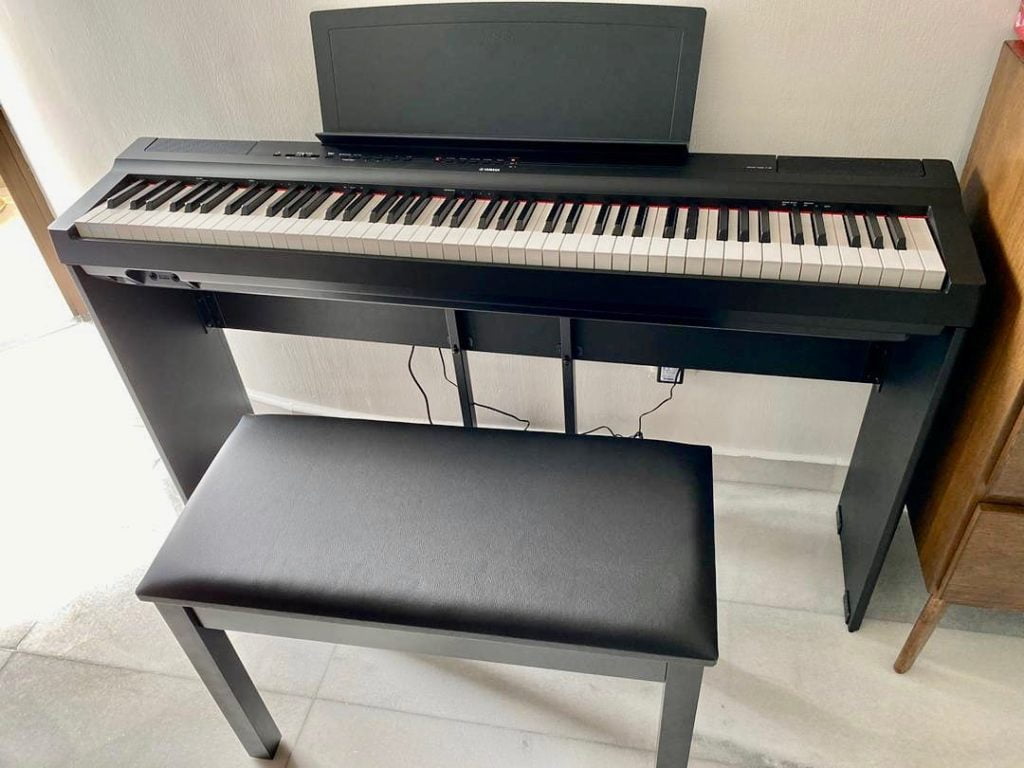
Both the Yamaha P115 and the P125 run on the same sound engine. However, the reason the Yamaha P125 is the winner when it comes to tone is because it has more voices and better effects, making it the more versatile piano option.
Tone Generation
When it comes to accurate tones, both of these pianos perform great. This is because they are equipped with the Yamaha PureCF Sound Engine. While it may sound like a complex software to generate sounds, it’s actually very similar to the common sampling process used by most budget-friendly pianos. However, what sets this engine apart from others is the actual samples that are used.
When recording the samples, Yamaha made sure to use top quality equipment to record high-quality and accurate sound waves. On top of that, they apply a digital filter over the sound to recreate a more accurate tone. However, the main reason the piano tones from the PureCF Sound Engine are great is because they were sampled from a Yamaha CFIII Concert Grand. This is one of Yamaha’s most famous models and boasts great tones, with which many pianists worldwide are familiar. So, when it comes to pure piano tones, you can expect a lot of things from both of these models.
Sound Library
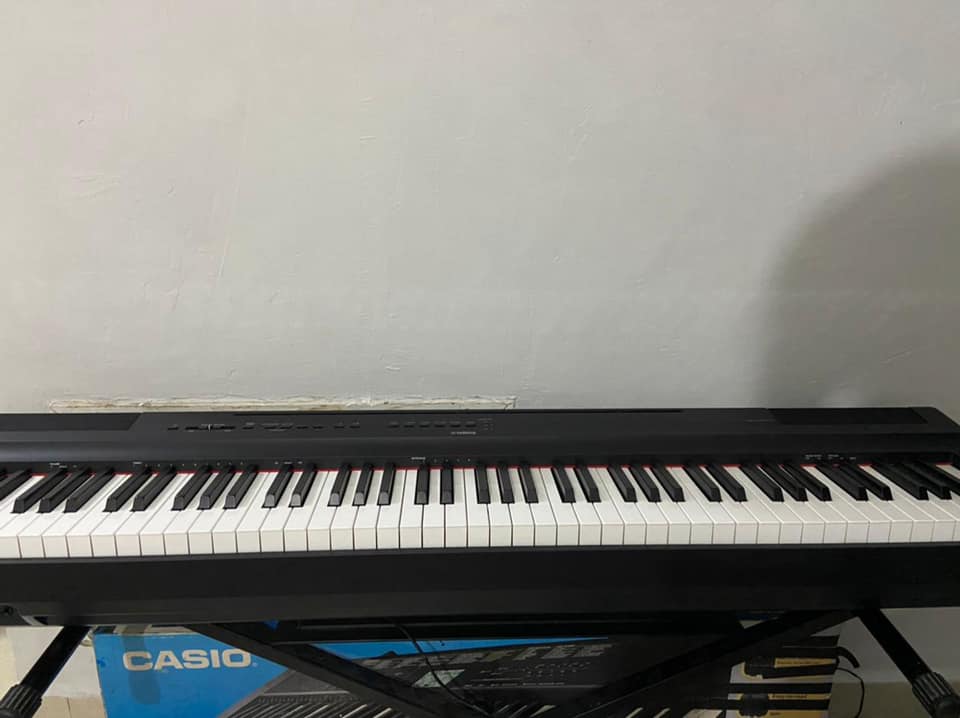
The main reason I found that the Yamaha P125 had better tones is the sound library. The Yamaha P125 comes with 24 different voices, while the P115 only comes with 10. Both of the pianos come with the standard voices such as a couple of acoustic piano, electric piano, organ, and string options. However, the Yamaha P125 has more variations and even synth sounds that you can use to experiment with different tones.
The reason a wider sound library is a great feature is that it gives pianists more freedom to experiment. When you start out with your lessons, it’s best to stick to the piano tones so that you don’t get confused. However, as you progress, it’s highly encouraged to experiment with other voices to really find your own sound. Since the Yamaha P125 has more voices, it’s a great instrument not just for beginners, but experienced and novice pianists as well!
Effects
Since the Yamaha P125 is the upgraded version of the P115, you can expect more robust effects. For starters, both pianos come with reverb. This provides a natural sounding echo to your tone, which is important for emulating the sound of an acoustic or grand piano. On both pianos, you can select different reverb presets depending on the sound you want. However, there’s no way to save your presets or personalized reverb tones on both pianos, which makes it hard if you’re particular about your tone.
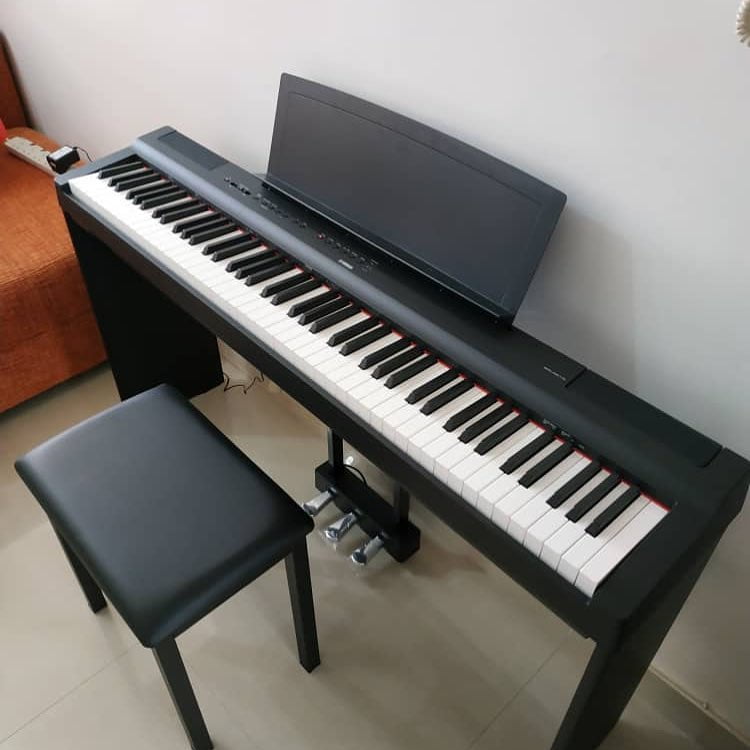
The Yamaha P115 only features reverb effects. While this is enough for a basic digital piano, the Yamaha P125 takes it a step further by adding damper resonance, IAC, and a sound boost. All of these effects can have a great influence on your tone, and the sound boost is a great help if you’re jamming with other musicians and need a few extra decibels so that they can hear you.
Piano Features
The winner: Yamaha P125
Piano features refer to all the extra things the piano has. And since the Yamaha P125 is an upgrade, it also comes with upgraded piano features. It features more accompaniment options and better app integration, which is why it easily beats out the Yamaha P115 in this regard.
Playing Modes
Both of these pianos come with dual, split, and duo mode. These all come in handy, especially for piano students who like experimenting with their tone. Dual mode allows you to blend different sounds on the piano. This is also called layering mode, and it allows you to load two voices on the piano at the same time. This makes for a great effect and also creates a unique tone that you won’t find on other digital instruments.
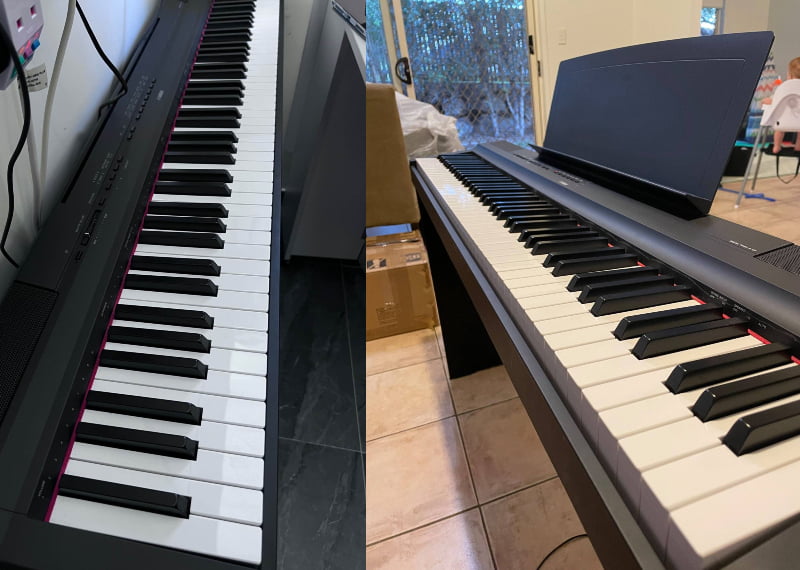
Split mode allows you to load two different voices on the piano. The difference is that with split mode, one side of the piano can trigger one voice while the other side triggers another. For example, you can have a bass voice on the left side and a synth voice on the right side. This gives off the illusion that you’re playing two instruments at once, and could come in handy when you’re performing or just jamming.
Lastly, duo mode splits the piano into two again, but this time it converts the 88-key keyboard into two tiny pianos. This means that both sides will play the exact same sounds. This is very helpful for piano lessons, as the teacher can demo the lesson on one side of the piano and get the exact same sound that the student gets on their side without having to cross over.
Both the P115 and the P125 have these features, which is why they are both versatile instruments great for piano students.
Accompaniment
The Yamaha P115 has some accompaniment features, but it pales in comparison to the P125. On the P115, you have 14 demo songs and 50 piano songs. Now normally, this would be great as not many other pianos in its price range feature this many accompaniment songs. However, the P125 ups the ante by providing users with 24 demo songs and 50 piano songs. This allows players to learn more songs on the piano while still having more than enough options if they just want to jam.
So, because of the varied accompaniment library, the P125 is the easy winner.
App Integration
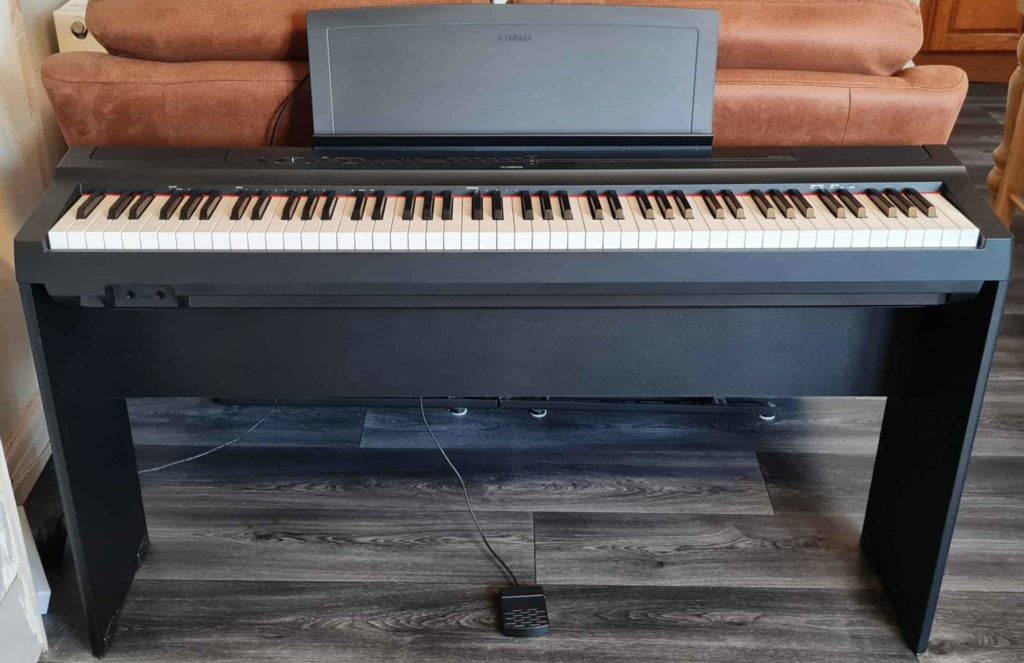
Both of these pianos can connect to an app on your phone. However, since the P115 is a much older model, the app is kind of outdated. The P115 uses the Yamaha Digital Controller App. This app allows you to do a bunch of things such as switch between different piano modes, tweak the reverb, turn on the metronome, and more. This is a great feature for beginners and is one of the reasons the P115 is one of the most popular options out there. However, the P125 improves on that by integrating with the Smart Pianist app.
Smart Pianist is very similar to the Yamaha Digital Controller, as it allows you to tweak certain parameters, switch between modes, and just about anything you can do with the Digital Controller. However, it does add one function called Chord Chart. This is a feature that shows you the chords of a certain song on your phone and then playing the song on the piano. This allows you to learn how to play your favorite song live while listening to it. This is a great lesson feature, and is the reason that the Yamaha P125 has better app integration than the P115.
One thing I can say about the Chord Chart feature though is that it’s really designed for beginners. It can handle basic songs very well, but once you get to the more complex songs with more complicated chords, the feature isn’t as accurate. On top of that, the Chord Chart has a wide variety of songs, but keep in mind there might be a fair chance your favorite song isn’t featured on the app, which is something you have to accept.
Yamaha P115 vs P125: The Similarities
Since the P115 is the predecessor to the P125, these pianos share a lot of similarities. While Yamaha made upgrades in the places that mattered, the brand made sure to preserve the best features of the P115 and apply them to the P125. Because of this, both pianos share a similar key texture and hammer action. Yamaha used their signature GHS (graded hammer system) for these pianos which make it feel like a real acoustic piano.
On top of that, these pianos both use the PureCF Sound Engine. As mentioned earlier, this sound engine does a great job of recreating the sounds from the famous Yamaha CFIII Grand Concert Piano. Both pianos also have a wide variety of different playing modes that give you a lot of versatility and room for experimentation.
Because of all these similarities, the Yamaha P115 remains a good option for beginners, especially those on a budget. However, if you’re looking for quality and a piano that will last you longer on your musical journey, the Yamaha P125 undoubtedly offers way more benefits and features.
Quick Rundown of the Yamaha P125
- A fully weighted digital piano with 88 full sized piano style keys
- GHS weighted action is heavier in the low keys and lighter in the high keys, just like an acoustic piano
- The pure CF sound engine faithfully reproduces the tone of the acclaimed Yamaha 9 feet CFIIIS Concert grand piano; Tempo range: 5 to 280
- Split mode lets you play a different voice with each hand; Tuning: 414.8 440.0 to 446.8 hertz
- USB to host connectivity with MIDI and audio transfer means you only need 1 cable to connect to your music making software
Last update on 2025-07-14 / Affiliate links / Images from Amazon Product Advertising API
Quick Rundown of the Yamaha P115
- GHS weighted 88 key action is heavier in the low end and lighter in the high end, just like an acoustic piano
- Amplifiers 7 W x 2.The Pure CF Sound Engine faithfully reproduces the tone of a meticulously sampled Yamaha's acclaimed 9 feet CFIIIS concert grand piano
- Pianist Styles turn your simple chords into exciting accompaniment. Play a chord and the Pianist Style gives you a full piano accompaniment
- The Controller App for iOS devices adds a rich, graphic user interface allowing for quick and easy navigation and configuration
- Includes PA150 Power Supply and a Sustain Pedal
Last update on 2025-07-14 / Affiliate links / Images from Amazon Product Advertising API
Product Video:
Related Articles to Yamaha P125
- Yamaha P150 vs P125: The Battle of the P-Series Models
- Yamaha P125 vs CLP 625: Can a Beginner’s Digital Piano Match the Clavinova?
- Yamaha P125 vs Roland FP 60: Which is the Better Investment?
- Yamaha P-121 vs P-125: Finding the Best Portable Yamaha Piano
- Yamaha P125 vs Korg LP 380: Which Piano Is Better for Your Needs?
- Yamaha P125 vs P85: Can the Outdated Digital Piano Beat the Newer One?
- Yamaha P125 vs DGX 670: Which Piano Comes Out on Top?
- Yamaha P125 vs Korg SP 280: Which is the Better Beginner’s Digital Piano?
- Yamaha P-255 vs P-125: Finding the Better Option for Beginners
- Yamaha P125 vs YDP S34 Comparison: Does the Portable P125 Hold Up Against a Console Digital Piano?
- Yamaha P125 Vs YDP 164: Should You Get A Console Or Digital Piano?
- Yamaha YDP 103 Vs P125: Should You Get a Portable or Console Digital Piano?
- Yamaha P125 Vs Kawai ES110 Comparison: Which Is The Best Portable Digital Piano
- Yamaha P125 vs Casio PX S1000: Which Digital Piano Is Worth Your Money?
- Casio PX-870 Vs Yamaha P-125: Should You Get A Portable Or Console Digital Piano?
- Alesis Recital Vs Yamaha P125: Which Is The Right Pick For You?
- Yamaha P45 VS P115: Which P-Series Newbie Gives You More Value for Money?
- Alesis Recital Pro vs Yamaha P125 Comparison: Which Is The Best Portable Digital Piano?
- Alesis Prestige Artist vs Yamaha P125 Comparison: Why the Yamaha P125 Is the Better Investment
- Yamaha P125 vs Casio PX-770 Review: Why the Yamaha P125 Beats Out the Casio Console Digital Piano
- Yamaha P125 vs DGX 660 Comparison: Can the P125 Hold Its Own Against the DGX 660?
- Yamaha P125 vs Roland FP-30X Review: Why the Roland FP-30X Comes Out On Top
- Yamaha P125 vs P515 Review: Why the Yamaha P515 Is the Better Investment
- Yamaha P125 vs Roland FP30: A Close Battle Between Two Great Digital Pianos
- Yamaha P45 vs P125: Why the Yamaha P125 Is the Better Pick for Pianists
- Yamaha P71 vs P125: Why the Yamaha P125 Is the Better Investment
Related Articles to Yamaha P115
References:
- P-115: https://usa.yamaha.com/products/musical_instruments/pianos/p_series/p-115/specs.html#product-tabs
- P-125: https://usa.yamaha.com/products/musical_instruments/pianos/p_series/p-125/specs.html#product-tabs
Lulacruza is an electronic folk duo operating at the junction of the hypermodern and the ancient. Our music weaves together hypnotic female singing, South American folk instruments and electronic processing, while channeling pulsating waves from the source of creation.
Lalucruza is also a community where you can connect with other music lovers to collaborate, exchange ideas and share knowledge. A platform for who wants to learns the basics of playing piano, guitar, drum masters’ technique, etc.. is the premise of our website.
